
What tobacco issue is important to Philip Morris?
Is Philip Morris "trust us" marketing subverting serious smoking prevention and cessation efforts? Who will be your child's teacher if they Google "youth smoking prevention," and what lessons will they learn?
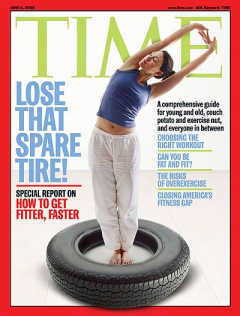 (Charleston, SC) June 3, 2005 -- The cover of the June 6, 2005 issue of TIME magazine promises that inside readers will find info on "how to get fitter, faster." As much as they'd like TIME to devote every issue to helping them push nicotine inside America's schools, tobacco companies wouldn't dare advertise in this issue, as three did just a week earlier.
(Charleston, SC) June 3, 2005 -- The cover of the June 6, 2005 issue of TIME magazine promises that inside readers will find info on "how to get fitter, faster." As much as they'd like TIME to devote every issue to helping them push nicotine inside America's schools, tobacco companies wouldn't dare advertise in this issue, as three did just a week earlier.
Unlike the May 30 issue of TIME, there would be no full-page announcement that R.J. Reynolds had just invented "the mellowest Camel ever," no offer of a free "sample carton" of healthier cigarettes for calling a toll-free number, and no full-page invitation to "enjoy tobacco." Clearly, the industry responsible for America's #1 cause of premature death would sit this TIME health issue out. Not Philip Morris.
Last Sunday, far too many camera shots of Philip Morris Marlboro racing team logos tarred the most exciting Indy 500 in recent memory. The race more than lived up to its billing as Danica Patrick's coming out party. But at what cost in terms of the number of youth who became loyal Marlboro fans?
The tobacco industry lives with the reality that mature minds are smart enough not to toy with what most drug addiction experts today consider earth's most captivating chemical. If WhyQuit.com's latest online smoking initiation survey anywhere near mirrors worldwide reality, up to 94% of smokers started smoking while children or teenagers, 28% experienced their first crave within smoking their first three cigarettes, and 20% found themselves craving nicotine within just two days of starting to smoke.
The 1998 tobacco settlement agreement between 46 states and all major U.S. tobacco companies contained a clause which stated, "No Participating Manufacturer may take any action, directly or indirectly, to target Youth within any Settling State in the advertising, promotion or marketing of Tobacco Products."
Since 1998 we've lived with the fiction that the tobacco industry would honor its agreement to slash its own throat by willingly forsaking 90% of its pool of new captive customers. Knowing that there would be few targetable replacements for the 440,000 U.S. nicotine addicts annually smoking themselves to death -- each an average of 5,000 days early - the agreement seemed to spell tobacco's doom and the industry's own premature demise.
But these guys are good. Enter Philip Morris with its 1999 "trust us" campaign under which it has actually grown its market share to 50%, and enjoyed a hefty 3.5% rise in cigarette sales during the first quarter of 2005. Not only did it allow Philip Morris to commence daily corporate name and image television marketing, it emboldened it to mingle and promote itself during health events, a place its competitors would not dare go.
Youth Smoking Prevention
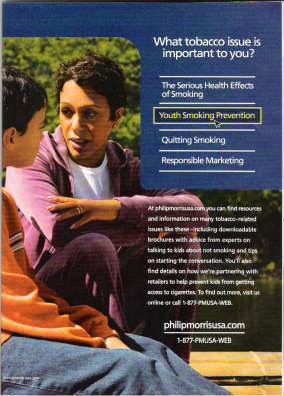 Just opposite a story on "getting fit," you'll find a full-page Philip Morris "trust us" image ad on page 71 of the June 6 edition of TIME. The ad pictures a mother talking to her son and is titled "What tobacco issue is important to you?" It lists four options: serious health effects of smoking, youth smoking prevention, quitting smoking, and responsible marketing.
Just opposite a story on "getting fit," you'll find a full-page Philip Morris "trust us" image ad on page 71 of the June 6 edition of TIME. The ad pictures a mother talking to her son and is titled "What tobacco issue is important to you?" It lists four options: serious health effects of smoking, youth smoking prevention, quitting smoking, and responsible marketing.
This particular TIME ad is about youth smoking prevention and invites readers to visit PhilipMoorrisUSA.com or call 1-877-PMUSA-WEB. During the free fully automated call, Philip Morris will offer to send you two different 16 page brochures and a third version in Spanish. The booklets are also available on its website.
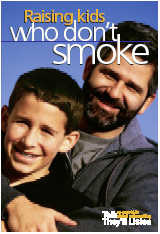 The first "trust us" booklet was released in 2003 and entitled "Raising Kids Who Don't Smoke" (PDF file). It is loaded with half-truths that are more confusing than honest. The second booklet was also released in 2003 and is entitled "Peer Pressure & Smoking" (PDF file). The third was released in 2005 and is also entitled "Raising Kids Who Don't Smoke" Let's look at muddy-waters from the first two.
The first "trust us" booklet was released in 2003 and entitled "Raising Kids Who Don't Smoke" (PDF file). It is loaded with half-truths that are more confusing than honest. The second booklet was also released in 2003 and is entitled "Peer Pressure & Smoking" (PDF file). The third was released in 2005 and is also entitled "Raising Kids Who Don't Smoke" Let's look at muddy-waters from the first two.
Page three of both booklets open with a blame transference letter from a Philip Morris selected child psychologist. We are not told if he was paid by Philip Morris but in "Raising Kids" he tells us that parents -- not tobacco companies - are the biggest influence on a child's decision to smoke. In "Peer Pressure," he tells us that the primary culprit is other kids.
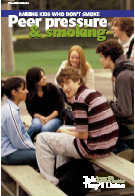 Although page 4 of "Raising Kids" briefly mentions the possibility of addiction, it does not warn youth or parents that smoking nicotine is extremely addictive. In fact, on page 13 of "Peer Pressure," Philip Morris falsely reassures youth that they can safely smoke for a few weeks without getting hooked.
Although page 4 of "Raising Kids" briefly mentions the possibility of addiction, it does not warn youth or parents that smoking nicotine is extremely addictive. In fact, on page 13 of "Peer Pressure," Philip Morris falsely reassures youth that they can safely smoke for a few weeks without getting hooked.
Although Philip Morris phrases it a bit differently, its words were carefully chosen. It advises a mother talking to her daughter to "tell her it's possible for teens to become addicted after only a few weeks of smoking." Where are our public health officials and why are they silent?
It gets worse. In discussing possible short-term effects of smoking, on page 4 of Raising Kids, chemical dependency isn't even listed. According to Philip Morris, the worst possible short-term effects of teen or preteen smoking are that they are "more susceptible to colds" and "experience shortness of breath more often than those who don't." Philip Morris makes experimenting sound almost harmless.
Page 9 of Raising Kids asks parents to compare smoking to activities such as cheating at cards, telling a friend she looks great when she doesn't, talking back to a teacher, teasing younger kids and swearing in public. Talk about leaving both parent and child confused.
But the deepest mud may be in intentionally creating confusion over whether smoking develops into a true permanent drug addiction like alcoholism, or is simply a nasty little habit like swearing or talking back to adults. Both booklets use the words "habit" and "addiction" as if interchangeable.
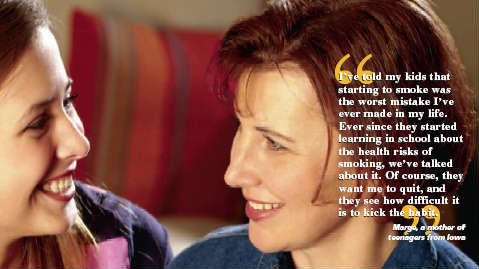 What is a child's definition of the word habit, a child who has never experienced chemical dependency? My guess is that it is very close to the definition provided by the American Heritage Dictionary - "a recurrent, often unconscious pattern of behavior that is acquired through frequent repetition."
What is a child's definition of the word habit, a child who has never experienced chemical dependency? My guess is that it is very close to the definition provided by the American Heritage Dictionary - "a recurrent, often unconscious pattern of behavior that is acquired through frequent repetition."
Is the average fifteen-year-old's understanding of the word "habit" akin to such activities as biting your nails or cracking your knuckles once too often, using too many cuss words for too long, or the driver mom just yelled at for not using their turn signals? In their minds, how long does it take to establish a habit? Can they get away with repeating the activity for at least a few weeks, the dependency onset time frame suggested by Philip Morris?
In their young mind, what does the word "habit" say about actual physical changes in the brain as neurons desensitize themselves to acetylcholine, the neurotransmitter that looks amazingly similar to the nicotine molecule? What does it say about nicotine causing a child's brain to grow millions of extra acetylcholine receptors in eleven different brain regions?
Could youth possibly be thinking that ending a habit such as biting your nails would cause full-blown physical withdrawal with powerful mood swings and hurtful anxieties? What does the word habit say about tolerance and the escalating need for greater amounts of nicotine in order to experience the same dopamine/adrenaline high?
The tobacco industry spends billions annually keeping society (and youth) conditioned to believe that all that smokers suffer from is a nasty little habit that resulted from going after flavor and taste a few times too often. What they'll never remind us of is the fact that there are zero tastebuds inside human lungs. So why inhale and briefly hold?
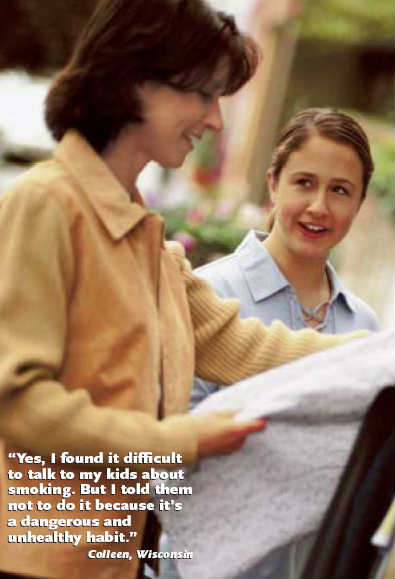 Is it coincidence that page 12 and 13 of both booklets contain large two-page images of mothers talking with daughters and the caption in the Peer Pressure image says, "But I told them not to do it because it's a dangerous and unhealthy habit," while part of the caption in Raising Kids reads, "Of course, they want me to quit, and they see how difficult it is to kick the habit."
Is it coincidence that page 12 and 13 of both booklets contain large two-page images of mothers talking with daughters and the caption in the Peer Pressure image says, "But I told them not to do it because it's a dangerous and unhealthy habit," while part of the caption in Raising Kids reads, "Of course, they want me to quit, and they see how difficult it is to kick the habit."
Even the page 3 expert child psychologists' letter in Peer Pressure calls smoking a habit in referring to a high school student smoking lounge. "Some of the seniors who went there started the habit because their friends did it, and because they saw smoking as a sign of maturity."
Neither booklet portrays the extremely addictive nature of smoking nicotine nor the daily nightmare of being hopelessly chemically captive to the ongoing horror of gradually destroy your body's ability to receive and transport life-giving oxygen.
Philip Morris simply cannot be fully open and honest without creating a booklet that might actually be effective in dramatically reducing youth smoking. It also has to worry that government health officials will use its dependency admissions as grounds for creating meaningful barriers between youth and tobacco marketing.
Both brochures intentionally keep readers in darkness of the fact that two-thirds of first time smokers will become addicted, while one-third become lifetime nicotine addicts. The brochures fail to warn youth that up to 86.8% of students who smoke nicotine at least once daily are already chemically dependent under Diagnostic and Statistical Manual for Mental Disorders, 4th Edition standards (DSM-IV).
If Philip Morris was truly serious about youth smoking prevention would its cigarette displays and signs be the largest in most neighborhood convenience stores, grocery stores and pharmacies, locations it knows to be frequented by children and teens?
Would the Marlboro name and logo be plastered on some of the world's fastest and most successful race cars, and become part of hero worship for young boys around the globe? Would it continue to use the Marlboro man and a bucking bronco to invite youth to see what the adventure and wild ride are really all about?
Quitting Smoking
Intended or not, isn't Philip Morris' "trust us" campaign delivering youth the message that if they get hooked that Philip Morris will be there to help them quit? Trust us! Isn't it telling youth that it is a world class authority when it comes to successful quitting? If true, where is its quitting program and just how successful is it? Amazingly, the world's most vocal authority on what works, and what doesn't, has no nicotine dependency recovery program - none.
If Philip Morris truly cared about the 70% of its customers who year after year assert that they want to quit but can't, wouldn't it make sure that every community across America had at least one effective local quitting program?
If truly caring, wouldn't it offer to fund a quality local program if none existed? Wouldn't the largest and most responsible U.S. nicotine merchant demand visible signs, at every nicotine sales location, advising addicts where to turn for effective help?
Or would it instead squander hundreds of millions worth of TV and magazine ads inviting hopeless and dying smokers to waste time visiting a website that offers no formal quitting program, no group or individual counseling, and no ongoing cessation support programs - none!
Have you ever noticed how no nicotine replacement therapy (NRT) commercial for the patch, gum or lozenge has ever said that cigarette smoking is bad for you? Have you ever wondered why? Have you ever wondered why Philip Morris keeps telling smokers that replacement nicotine is key to quitting?
What millions of quit-dreaming smokers won't read in their wasted trip to Philip Morris' website is the truth about over-the-counter (OTC) nicotine replacement products. The site keeps quiet the fact that a March 2003 study combined and averaged all seven OTC patch and gum studies and found that 93% of study participants had relapsed to smoking within six months.
Philip Morris' Quit Assist Internet materials keep secret the important fact that if they've already tried the nicotine patch once and relapsed, that the only two patch recycling studies ever conducted found that the odds of quitting smoking for six months during a second patch attempt drop to near 0% (April 1993).
Although Philip Morris asserts that NRT is scientifically tested and proven to double your chances of success, it fails to caution smokers that a June 2004 NRT study review found that NRT studies were not blind as claimed. Yes, it's very possible that NRT studies reflect junk science of the worst order.
You also will not find Philip Morris telling quitters that out in the real-world, away from pharmaceutical industry influence and formal clinical studies where all participants had expectations of receiving weeks or months of free replacement nicotine, that smoker quitting surveys continue to find that there is absolutely zero advantage at six months for those attempting to quit with NRT - absolutely none! Nor will it tell them that a November 2003 study found that up to 36.6% of current nicotine gum users are chronic long-term users of greater than six months.
Responsible Marketing
If Philip Morris was serous about responsible marketing, wouldn't it voluntarily take immediate steps to ensure that its products are not sold or shotgun marketed inside any business location allowing access to children? Why compel forced responsibility?
If responsible, why would it allow its products to be store marketed by use of exterior Philip Morris tobacco advertising signs that blast away at youth on sidewalks, in passing school buses, or in vehicles? Why would it allow any sales in close proximity to schools?
Instead of its failed "We Card" voluntary enforcement facade, shouldn't Philip Morris be fighting for legislation that imposes serious penalties upon businesses who knowingly sell nicotine delivery products to underage youth? Here in S.C. the fine for selling cigarettes to a ten-year-old is $25 and is so ridiculously low that I doubt it has ever been imposed.
 Isn't the visible public use of a product also an important marketing element? If so, why would Philip Morris fight against clean and healthy indoor air movements? Why would it demand that children watch and smell public indoor nicotine feedings as they attempt to eat in restaurants across the nation?
Isn't the visible public use of a product also an important marketing element? If so, why would Philip Morris fight against clean and healthy indoor air movements? Why would it demand that children watch and smell public indoor nicotine feedings as they attempt to eat in restaurants across the nation?
Wouldn't smoke-free indoor work environments provide temptation free havens to the 70% of Philip Morris customers dying to break nicotine's amazing grip upon their mind, health and life expectancy?
And as for smoking nicotine being extremely addictive, why on God's green earth would any "responsible" tobacco merchant not voluntarily place addiction warning labels on every pack sold? There is no U.S. addiction warning label. Philip Morris is entirely free to add one, without our government compelling it to do so, but it won't. Why?
There have long been bills pending in Congress to mandate express warning of smoking's earliest and most critical risk. But the language is so watered down ("cigarettes are addictive" - passed into law since this article was written) and diluted by required rotation among long-term health risks that the warning's impact will likely be negligible if any.
Take a close look at Canada's required addiction warning label. Required since 2000, youth smoking rates have taken a five year nose dive. It reads, "WARNING - CIGARETTES ARE HIGHLY ADDICTIVE - Studies have shown that tobacco can be harder to quit than heroin or cocaine." Why keep truth from youth?
Is Philip Morris' entire corporate responsibility campaign simply a thin greed driven facade behind which it's business as usual? Can it truly pretend to care about its 20 million addicted U.S. customers when all it offers them are shallow corporate image commercials and more "trust us" ads?
Philip Morris is in the drug addiction business. It knows it feeds upon youth. It knows how to immediately stop feeding upon youth. Amazingly, it has grown so skilled at marketing that it can hide its corporate purpose inside fitness magazines. What insult next?
Related Philip Morris Reading
- Marlboro "Maybe" Archetype Ad Campaign - October 29, 2013 - Is Philip Morris International (PMI) currently toying with neuronal definition imprinting within a child's subconscious mind? View 45 Marlboro "Maybe" ads and contrast the lessons being taught to a 1991 Philip Morris study entitled the "Archetype Project."
- Marlboro maker's report ignores youth addiction - October 22, 2013 - Article reviews how Philip Morris International's 2012 Annual Report ignores discussing PMI's core business, nicotine addiction, or the fact that the vast majority of new regular customers were addicted children and teens.
- Nicotine Patch Inventor Fudges Patch Study Findings - July 12, 2009 - Why would Philip Morris fund a nicotine patch smoking cessation study (see 2004 Funding Agreement)? Although not shared in this article, the answer is simple: PM knows that replacement nicotine is horribly ineffective (see July 2013 Gallup Poll).
- Philip Morris revises "Raising kids who don't smoke" - December 5, 2005 - Why parents wanting to teach their child or teen the unabridged truth about smoking might be wise to select a teacher other than Philip Morris USA
- Philip Morris' "Could your kid be smoking?" - August 8, 2005 - A critical review of Philip Morris USA's third sixteen-page youth smoking prevention brochure entitled, Could your kid be smoking?
- Understanding Philip Morris's pursuit of US government regulation of tobacco, McDaniel, PA, et al, Tobacco Control, Volume 14, Number 3, Pages 193-200, June 2005 (link to free full text article)
- Financial Ties and Conflicts of Interest Between Pharmaceutical and Tobacco Companies - 2002 - a study detailing Philip Morris' uneasy partnership with the pharmaceutical industry, and why you have never and never will hear any nicotine replacement product commercial tell you why you need to quit, because smoking kills.
- Philip Morris' Mission Exploration Project - June 27, 2000 - A 140 page PDF file outlining Philip Morris USA's plan for, in part, transforming itself into a highly respected nicotine pharmaceutical company, the same vision RJ Reynolds had in 1972.
- Philip Morris' Archetype Project - August 20, 1991 - A 16 page PDF file detailing what Philip Morris USA learned from its archetype sessions about imprinting smoking upon the neuronal pathways of a child's brain.


